Posted by Filiberto Boncompagni on 02-18-2006 10:52 AM:
Yastik
Dear all,
It seems the discussion is focalizing only on one rug. Let’s move on something
else.
I know almost nothing about Anatolian yastiks, but I like this one.

It seems I’m not alone in liking it, since it fetched an awesome lot of money
in a recent auction.
Any thoughts?
Regards,
Filiberto
Posted by Tim Adam on 02-18-2006 04:52 PM:
Hello all,
This yastic is published in MOREHOUSE: "Yastiks - Cushion Covers and Storage
Bags of Anatolia" plate 59, page 49. Could someone who owns this book be kind
enough and post Morehouse's discussion of this piece?
Tim
Posted by R. John Howe on 02-18-2006 05:21 PM:
Hi Filiberto -
One thing that struck me immediately was that again there is an early estimated
date of weaving and yet the drawing is pretty abstracted. This tends to violate
our frequent sense of how things should be. An older yastik should be complex,
we might say, and in truth some are.
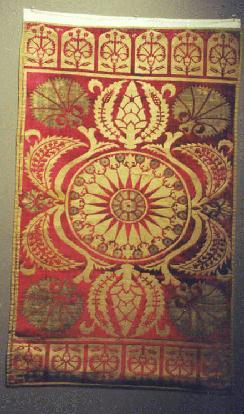
But it is also true that very early yastiks (and other weavings) can be quite
simple. In Dan Walker's "Seldom Seen" exhibition, there is a yastik of a velvet
and (originally) silver that he selected in part because of the severity of
its design.
Here, again, is the link to the "Seldom Seen" images. Go down 10 images to see
this yastik which is presented long sides vertically in the exhibition.
http://www.textilemuseum.org/about/imageListSeldomSeen.htm
We've seen this piece before. It was included in a salon based on a TM rug morning
some time back featuring Ottoman material from the TM collection.
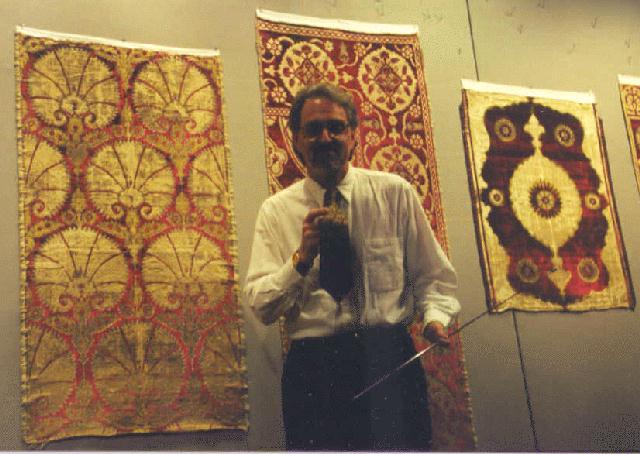

This piece is estimated to have been created in the 16th century.
I think this simplicity coupled with age suggests that our frequent assumption
that designs move from more articulated versions to those that are abstracted
may frequently be true, but also can be false. Weavers may chose quite abstracted
designs in any age. And evolution can be toward abstraction, but also toward
elaboration.
So one thing to note about this piece is that its seeming conventionalization
of design may not be a basis for questioning its estimated age. Such things
happen.
I should add that facing it in the wool it appears to be in very good condition.
"Full pile" would not in my view be an exaggeration.
The blue-green in it is one of the most unusual colors I can recall seeing in
a piece and the overall color use of a quite limited palette is to me very,
very effective.
Regards,
R. John Howe
Posted by Filiberto Boncompagni on 02-19-2006 06:45 AM:
Some mistakes happened in matching the exhibition labels with the related photos.
This is the correct text for the yastik under discussion in this thread:
Pile Cushion Cover, yastik, 18th Century; Central Anatolia, Karapinar
Collection of Ted Mast (ARG 17)
The quatre fleurs design of tulips, roses, hyacinths
and carnations identifies a particular 16th-century development in the creation
of an Ottoman style.
Many of these design elements remained well into the
19th century in western and central Anatolia, village weaving traditions.
This exemplary yastik joins other weavings in this exhibition thought to have
been made in the region. Certain structural and aesthetic characteristics of
these pieces are consistent. Here, four large blue tulips are
seen in the red spandrels; they appear again inside
the aubergine medallion along the vertical axis. Along
the horizontal axis are two red rosebuds attached to a
red central boss.
The rows of detached arches along the top and bottom of this cushion cover are
often seen in yastik design. The side borders carry a series of crescents on
a pale blue-green ground. The handsome composition is balanced and the skillful
drawing stylized yet refined, indicating an accomplished weaver at work and
signifying that this yastik was made with a special purpose or owner in mind.
Regards,
Filiberto
Posted by richard tomlinson on 02-19-2006 08:50 AM:
hello
I am sorry to say this (filiberto) but this yastik is one of the blandest, most
uninteresting examples i have seen.
i know nothing of structural aspects, but the design is static, the colors look
like modern vegetal dyed pieces - the abrash, especially the blue looks contrived.
if i didnt know better, i'd call it fake.
this piece has no life in my eyes. i have seen some wonderful yastiks - this
pales into insignificance.
in summary- AWFUL !!!
am i the only one who sees this piece as lacklustre?
richard tomlinson
Posted by Filiberto Boncompagni on 02-19-2006 09:06 AM:
Hi Richard,
As they used to say, de gustibus non est disputandum.
Surely the guy who bought it last November at Rippon Boswell must have liked
it a bit more than you do. 
Regards,
Filiberto
Posted by Ben Mini on 02-19-2006 09:16 AM:
Richard, did you notice the small area of faded repiling on the top corner?
If this is a fake, that's a classy touch. I would also like to talk about the
color scheme as seeming, well, not like the color scheme one might expect on
a 200 year old Karapinar. Again, we have red, white, and blue, plus a rather
brown aubergine (or is that just a bad photo?). I've come to expect luscious
purples on 200+ year old Central Anatolian rugs, not brownish aubergines. And
where is the apricot, or yellow, or green? I don't mean to come off as overly
negative here, but thus far it seems that there is some very, very ambitious
dating in this exhibition.
Ben Mini
p.s. how many other 200+year old pile yastiks are there out there? I'm not asking
about velvet or flatweave, but pile yastiks. Who has seen one that they are
sure is at least 200 years old?
Posted by Bob Kent on 02-19-2006 09:21 AM:
yastik and rest of exhibit
Hi richard! I live in Philly and have been to this fantastic exhibit a few
times. A few things I'd note. First, the purple of the yastik is a good bit
lighter in person versus this computer image, at least on my monitor, and that
might look better in person. Still, the yastik did not do a lot for me versus
some other things the show, so the yastik is probably actually great!  I am a new collector with limited
experience, so of I have no idea about the yastik. But I do wonder how datings
to for example the 18th C for a yastik -- certainly, a utilitarian, unsigned,
and undated thing in its day, and not the sort of thing with a chain of custody
back that far -- might be done. If there isn't a useful physical C-14 sort of
test (and I suppose even if there were the wool could be old in a repair, etc),
then I guess design and structure, as the legend in the show suggests, might
be used to gauge age. Design could be misleading - an old design might reused,
like a replica car or house with archaic design. And if structure is a guide,
surely the best restorers know as much as collectors about structural things,
so in the presence of much higher prices for things deemed really old, things
might be restored in convenient ways?
I am a new collector with limited
experience, so of I have no idea about the yastik. But I do wonder how datings
to for example the 18th C for a yastik -- certainly, a utilitarian, unsigned,
and undated thing in its day, and not the sort of thing with a chain of custody
back that far -- might be done. If there isn't a useful physical C-14 sort of
test (and I suppose even if there were the wool could be old in a repair, etc),
then I guess design and structure, as the legend in the show suggests, might
be used to gauge age. Design could be misleading - an old design might reused,
like a replica car or house with archaic design. And if structure is a guide,
surely the best restorers know as much as collectors about structural things,
so in the presence of much higher prices for things deemed really old, things
might be restored in convenient ways?
Posted by Tim Adam on 02-19-2006 09:33 AM:
Hi Richard,
No, you are not the only one ( John, are you surprised?  ). I had pretty much the same reactions as you did, except for the final conclusion.
I don't think it is awful, but I would surely not pay those mega bucks for it.
). I had pretty much the same reactions as you did, except for the final conclusion.
I don't think it is awful, but I would surely not pay those mega bucks for it.
It is amazing that despite the abundant abrash the yastic feels very 2-dimensional
(except for the border). I also think that the shape of the central medallion
is rather plump, and not what I would associate with a ca. 1800 piece. There
is no elegance, no movement. Together with the perfect condition this is exactly
what I'd imagine a fake would look like.
Tim
Posted by Lavergne Philippe on 02-19-2006 10:46 AM:
plate 59
Tim wrote:
Hello all,
This yastic is published in MOREHOUSE: "Yastiks - Cushion Covers and Storage
Bags of Anatolia" plate 59, page 49. Could someone who owns this book be kind
enough and post Morehouse's discussion of this piece?
Tim
Bonjour tout le monde : this is the text page 89:
Catalog nos. 58-59 ( in part « Central Anatolia », opposite Eastern)
Though these two examples are very different in spirit, the field design of
cat. no. 58 is in many respects a geometrized version of cat. no. 59. A central,
vertically oriented oval form encircled by blossoms is placed in a hexagonal
medallion (the shape of the medallion is rather clearer in cat. no. 58); the
corner spandrels contain tall tulips. In both pieces the design elements are
outlined in a contrasting color, a feature which is seen in Karapmar rugs and
which suggests an attribution for these yastiks. Likewise the pendant which
extends from the top and bottom of the medallion in cat. no. 58 is a form seen
in early Karapinar rugs. The strict adherence to symmetrical duplication of
unconnected forms seems to be a prevalent feature in this group and is also
seen in Caucasian carpets. The general character of cat. no. 58 is in some ways
more Caucasian than Turkish, and Iten-Maritz notes that the weavers of Karapmar
are descendants of peoples who migrated from the Caucasus in the 9th and 10th
centuries. Nowhere is this connection more clearly seen than on a Caucasian
soumak khorjin illustrated in HALI that displays design elements seen in cat.
no. 58. Neither piece has corner brackets and both have borders comprised of
simple, unconnected red forms on a blue ground. The bold crescents in the side
borders of cat. no. 59 are very unusual and the design of the lappets on this
piece is likewise not a traditional form. (Cat. no. 58: Burns collection. Cat.
no. 59: Newman collection.)
References: For the discussion of the links between Karapinar and the Caucasus,
see Iten-Maritz, Turkish Carpets, p. 300; for the soumak bag, see HALI 62: p.
96.
58: 3'9"x2'l" WARPS: Lt. brown; Wool; Z2S; Flat. WEFTS: Lt. brown; Wool; Z 2;
Semi-straight; 2 between rows (inserts of 3). KNOTS: Symmet; Wool; Z 2; Per
sq. inch/56 - 63 (ver. 7, hor. 8-9). ENDS: Not original? EDGES: Not original?
59: 4' x 2'1" WARPS: Ivory; Wool; Z2S; Flat. WEFTS: Dk. ivory; Wool; Z; Semi-straight;
2, 3 between rows (inserts of 4). KNOTS: Symmet.; Wool; Z 2; Per sq. inch/ 70
(ver. 7, hor. 10). ENDS: No plain weave. EDGES: Main wefts interlace several
sheds on 2 warps beyond pile area, returning on next row above, sharing those
2 warps with supp. elem. interlacing. Supp. elem. sequen. interlac. of 4 sets
of paired warps, every other row of supp. elem. interlaces 2 warps of pile area.
Wool; Z2S; Lt. orange-red, red.
Au revoir
Phil
Posted by Filiberto Boncompagni on 02-19-2006 11:27 AM:
This is yastik 58 in Morehouse’s book, courtesy of Philippe:
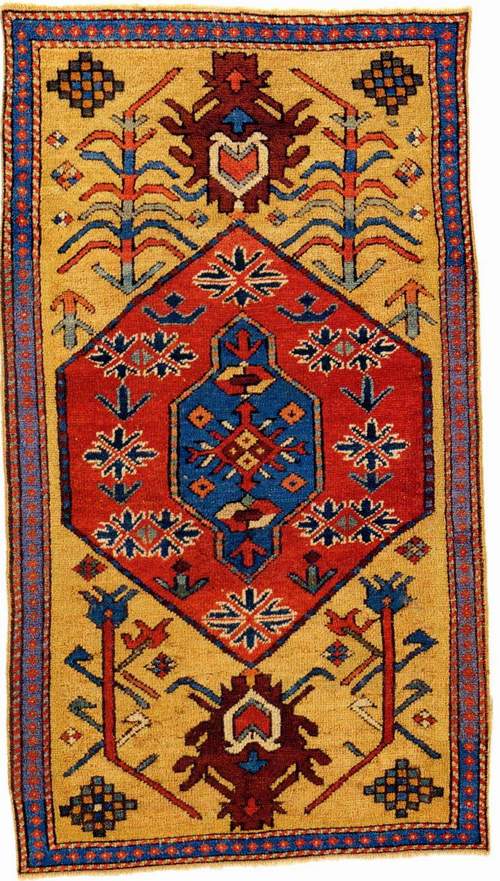
Merci Philippe,
Filiberto
Posted by Cevat Kanig on 02-19-2006 12:37 PM:
Hi ,
It is a very nice Karapinar Yastik, i love it!, the bordur of the yastik is
"C " reminded me Turkoman C gul.
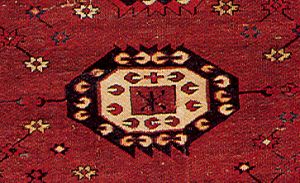
Posted by Lars_Jurell on 02-19-2006 03:18 PM:
Hello all
I got the book "Yastiks" and I have followed your discussion about Number 59
and now also about number 58.
Having a close look at them, as close you can do in the computer,
the condition of the first one seems to be too perfect for beeing about 200
years old. Even with some repaired parts I would expect some marks of age on
it. And also number 59 ( but nobody told the age of that yastik ).
And as they both are yastiks, but only fronts, which means fronts of pillows
with flatweaves on the backside from the beginning, and number 59 is very old,
why is the front in perfect condition but all the backside removed, including
some rests of flatweave in both ends?
Photos are photos, but now I might agree with Richard Tomlinson that the colours
looks like modern vegetable dyes. I have seen a lot of Turkish yastiks and rugs
of high quality and weaved just some years ago with vegetable dyes.
It would be of big interest if someone can show detail photos from theese two
yastiks.
Lars Jurell, Sweden
Posted by R. John Howe on 02-19-2006 07:48 PM:
Guys -
We entertain a nearly free environment here for indicating what we think of
pieces posted.
But, I would argue, we need to be careful not to make rather superfical, "knee-jerk"
evaluations of this piece without much real information about it.
"Throwing stones" immediately after an introduction is in some circles seen
as simply ill-mannered.
If this piece is as obviously as uninteresting (some stronger language has been
used) as some think, it might be good to note that it has likely fooled quite
a few very experienced people over at least several years. (Not that that has
not happened before on occasion. But it's an indicator that suggests caution
rather than conclusion.)
It's one thing to note as I did that the order of abstraction is not what we
usually expect in a piece estimated to have been woven in the 18th century,
but some have moved rather quickly to very severe conclusionary judgments (some
even seem to suspect chicaney) on the basis of pretty thin image evidence.
We are absolutely free not to like it, but it might be useful also to ask why
it is that a number of rather experienced folks seem to evaluate it quite differently.
If they can be so wrong, it would seem possible that so can we.
Regards,
R. John Howe
Posted by Tim Adam on 02-19-2006 08:57 PM:
Hi John,
I don't think people are making superfical, "knee-jerk" evaluations here. The
color scheme, the design, the abrash, and the condition put some doubt on whether
this yastic is 18th century as claimed. Those seem to be fair points.
It would certainly help the dicussion if the more experienced folks, who evaluate
the yastic differently, would step forward and provide some additional information.
Regards,
Tim
Posted by Michael_Wendorf on 02-19-2006 10:11 PM:
Karapinar Yastik
Dear Readers:
I have known and handled on several occasions the Karapinar yastik that is exhibited
in Philadelphia and being discussed here for nearly 15 years. I first saw it
displayed in the living room of the long time New Jersey dealer Ronnie Newman
where lit against a wall its color completely radiated throughout the room.
I have seen it displayed to similar effect elsewhere. This yastik has a presence
that few pieces can match.
The limited and saturated colors appear somewhat darker in the image as it appears
on my monitor than I recall it in the flesh. In the flesh, the blue green is
a lovely old color that frames the field and sets off the design in a magical
way for me. i cannot say with assurance how old this yastik is, only that it
is old - I base this on handle, color and weave. Many people much more experienced
and knowledgeable of old yastiks have handled and concured with this opinion.
I cannot agree personally with the opinions expressed here that have described
this yastik as lacking elegance and movement or the design being static. Certainly
the format is at first glance a fairly formal central medallion with quarter
spandrels with expected symmetry. However, the inward splay of the tulips and
the assymmetry of some of the filler motifs give even the field the a playfulness
within the structure without shouting. And the border carries, in my opinion,
this composition again without shouting but also with subtle disruption of the
design symmetry expected of such a medallion design.
I am not a yastik collector, but having some appreciation for the design and
weaving traditions from which this yastik comes as well as its color and tactile
qualities I have always admired this piece. I think it deserves some contemplation
and certainly it deserves more than what John Howe has described, accurately
I believe, as knee jerk reactions. Everyone is entitled to their opinion, but
better that opinion results from something deeper.
Best wishes, michael
Posted by Ben Mini on 02-20-2006 11:59 AM:
I am glad that advocates of this Yastik came into the discussion. That helps
to move things one, and helps to clear up some initial doubts. Online discussions
are spirited, feisty affairs, and I would hope that none take offense to a general
tendency to put things bluntly online.
Michael, I found your post particularly helpful. Still, I think we can have
a civil discussion about the date for this yastik.
John, I'm afraid I was put off by your scold to the "ill mannered" hoi polloi.
I don't think that will help to draw more people into this discussion, and I
don't think that things were nearly as ugly as you implied.
Ben Mini
Posted by Bob Kent on 02-20-2006 12:21 PM:
what about the handle/weave?
Hi mw; First, I think that people's immediate reactions to a rug are interesting,
and Thomas Hoving, foremrly director of the Met, argues that they can be telling
about art. For the yastik, they were probably affected by the date given? For
what its worth, I actually didn't remember the yastik after my first visit,
I just liked other stuff, usak and c anatolia prayer. Can you remember what
about the weave and handle of the yastik suggested age to you?
Posted by Filiberto Boncompagni on 02-20-2006 12:43 PM:
Dear all,
quote:
References: For the discussion of the links between Karapinar and the Caucasus,
see Iten-Maritz, Turkish Carpets, p. 300
I would be VERY grateful if some owner of the book in question could scan the
text on page 300 (better if using Optical Character Recognition) and send it to
me.
Thanks,
Filiberto
Posted by Michael_Wendorf on 02-20-2006 10:03 PM:
Yastik
Dear Readers:
I cannot help with the request for Iten-Maritz. But I can perhaps expand a little
on my opinions about this yastik.
I think Bob Kent's reference to Hoving and the importance of initial or visceral
reactions to art is legitimate. But when Hoving talks about such initial reactions
or visceral reactions what does he or we pre-suppose as the knowledge base of
the viewer and does it matter? My initial response to this piece in the flesh
was to color and drawing - I found it captivating with real presence. It was
also 15 years ago - I do not know if the reaction would be the same today.
I think the dating to the 18th century is controversial. However, I also wonder
how relevant it really is. The dating of a varient piece such as this is always
problematic. Ronnie Newman himself would probably respond to the question of
age by stating simply "It is older than all the rest." I would probably say
simply, "it is old enough." Since we have no anchor pieces of 18th century date
in knotted pile to make a direct comparison against, our opinions will always
be speculative to a significant degree. That said, I still do not think this
yastik is new or modern. New pieces that I have handled have a drier wool, stiffer
handle and distinctive back that is hard to describe but less difficult to feel
and as, Richard Tomlinson accurately stated, a contrived abrash. This piece
is different, the wool is shinier and glossier than new wool, the handle is
floppier, the abrash right. What Mr. Dodds and others who have sought to date
the piece no doubt confront is a relationship to 16th century works and a tradition
moving forward rom that time. assuming this piece is old and perhaps older than
all the rest and part of that design continuum - where then to place it? 18th
century? As good a guesstimate as any other.
There is a alternative dilemna/scenario - a very savvy friend one told me and
reminded me again recently that varient pieces should always be scrutinzed because
it often turns out they are what several people in this thread have suggested
- fakes; not necessarily modern fakes but fakes made 100 years ago or even more.
Perhaps this is the real issue with this piece and the response of some to it.
Here a deconstruction of the design elements and a comparison to the known tradition
and historical antecedents does raise some important/troubling issues - the
scale of drawing, the crescent design elements in the border and the way they
merge into the stylized lappets on the ends, the size and drawing of the spandrels
and the inclusion of some odd seemingly out of tradition elements such as the
8 quartered octagonal devices surrounding the central medallion in place of
rosette forms as well as the cresent motifs in the side borders. Is it real
or is it an old fake - perhaps our appreciation of this yastik and the tradition
it either is part of or trys to imitate is deepened by our contemplation of
these issues?
I leave it to each of you to decide for yourself with best wishes, michael
Posted by Filiberto Boncompagni on 02-21-2006 03:36 AM:
Hi Michael,
I am rather skeptical with the possibility of this piece being an old fake (intending
as “fake” an art object expressly made to deceive the customer).
As I said, I know nothing about Anatolian yastiks and their iconography and
I’m not able to infer the supposed stylistic incongruence that could point out
to a fake.
To tell the truth, I’m also skeptical about the use of this kind of criterion
on folk art, given the fact that folk art is always a generally faithful but
not verbatim repetition of old norms (design and layout, color, and so on) with
- sometimes - sudden bursts of creativity departing from the norm.
Then, if this piece is really at least 100 years old as I think you suggest,
the question is:
was there a demand for this kind of “rustic” fakes at the time? I would expect
an ancient forger to make a copy of a classical carpet, not of a village mat.
We discussed about modern fakes some time ago:
http://www.turkotek.com/salon_00085/s85t11.htm
http://www.turkotek.com/misc_00010/m10t1.htm
Interestingly, the fake discussed mainly in the first thread is still on the
market, offered on a web site as Zakatala.
Somebody I know, believing that the seller was in good faith, tried to alert
him.
The dealer acknowledged the problem but, on the pretext that he was busy, promised
to remove it later. A year went, and the “Zakatala” mat is still there. 
Regards,
Filiberto
Posted by Filiberto Boncompagni on 02-21-2006 03:51 AM:
Oooops!
To be fair with the dealer: I just checked his website and realized
that the “Zakatala” mat is sold as “Traditional design” and not as an “Antique”
like other Zakatala pieces sold on the same site.
Looking at other pieces with the “traditional design” diction it’s evident that
“traditional design” means “reproduction” in that particular web site.
Regards,
Filiberto
Posted by Steve Price on 02-21-2006 05:58 AM:
Hi Filiberto
I think the word "fake", as used in Rugdom, doesn't necessarily mean that a
piece was intended to fool a buyer into thinking it was something else. Western
and central Asian bazaars had lots of rug shops long before Americans and Europeans
came in large numbers looking for souvenirs, so there must have been a substantial
local customer base. Believing that some weavers made rugs that varied from
tradition in an attempt to attract contemporary buyers doesn't seem unreasonable
to me.
In a nutshell, I prefer the word "unauthentic" to "fake", since it carries no
ethical baggage or suggestion of an attempt to deceive.
Perhaps reference to other art forms is appropriate. Would you consider Prokofieff's
"Classical Symphony" to be a fake? I doubt that anyone would attribute it to
a Russian composer if exposed to it without prior knowledge of what it is.
Regards
Steve Price
Posted by Filiberto Boncompagni on 02-21-2006 06:10 AM:
Hi Steve,
That’s why I stated what I mean as fake: an art object expressly made to
deceive the customer.
My impression was that "fake" was used exactly with that meaning in this thread.
Regards,
Filiberto
Posted by Steve Price on 02-21-2006 06:51 AM:
Hi Filiberto
You made your meaning clear, but I'm not sure that this was the only thing Michael
had in mind. The issue is whether this yastik is modern or old (and, since Michael
has handled it and says that he doesn't think it's modern, I doubt that it is
modern).
But "old" doesn't necessarily mean that it was made at the same time and place
as more or less similar pieces. It might be a fake (literally) made more than
100 years ago, but it might also have been made for the local marketplace, adopting
traditional designs, layouts and colors to the then-modern taste.
Regards
Steve Price
Posted by R. John Howe on 02-21-2006 08:03 AM:
Dear folks -
I just want to put up another (entirely unrelated) piece here to demonstrate
that the kind of indicators that are being used in what seems to me to be a
prematurely, conclusive and negative way, can sometimes point in quite different
directions.
The piece below is a Kazak niche format rug from the Kaffel volume.
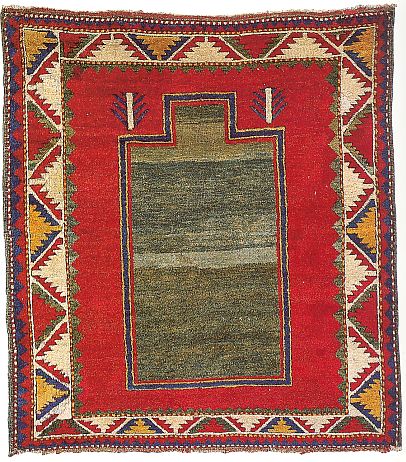
It has very simple designs and a marked use of an abrashed green. Kaffel indicates
that it is estimated to have been made in the "mid-19th century," says that
a high price was paid for it too, likely in part because of its "minimalist"
design. Kaffel quotes the auction catalog which describes this piece as "rare"
and says its "tremendous impact comes from it perfectly balanced design and
pure, saturated colors." Kaffel put this piece on his dust jacket.
It seems to me that on a number of the indicators being cited this piece is
analogous to the Anatolian yastik under discussion in this thread.
About dating yastiks. Someone asked how many "pile 18th century yastiks" can
we point to. I took a look at the Morehouse book. Morehouse, in one of his early
sections provides images of three pile yastiks that he says seem reliably dated
to the 17th century. But in the next section on dating yastiks he says "...Determining
the age of yastiks must be viewed with caution. Lacking any proven scientific
method, we are left with experienced judgment..."
This may be one reason why there seem to be NO age estimates included in the
technical descriptions of the pieces in this volume. Morehouse does indicate
that Plate 101 is dated to approximately 1831, the oldest dated yastik we appear
to have.
So the dates being offered are likely the result of "experienced judgment" which
can differ and about which there is often question.
Regards,
R. John Howe
Posted by Steve Price on 02-21-2006 08:39 AM:
Hi John
Some comments about Morehouse's statement, ...Determining the age of yastiks
must be viewed with caution. Lacking any proven scientific method, we are left
with experienced judgment.
The problem with "experienced judgment" is that unless someone's experience
comes from handling yastiks of known age, of which there are very few, the experienced
judgment has little basis other than the judgment of his mentors or his own
guesses, reinforced by repetition.
Most attributions of age or place are actually based on similar pieces having
been given some attribution that is adopted for the piece in question. We see
that frequently in all sorts of places. The reliability of the published source
is hardly ever questioned.
Regards
Steve Price
Posted by Filiberto Boncompagni on 02-21-2006 09:17 AM:
Hi John,
Good example. That prayer rug (my favorite – I wish it was mine too)
could be a highly simplified version of the Fachralo-type. See Kaffel’s plate
10 and 15, both identified as Fachralo:
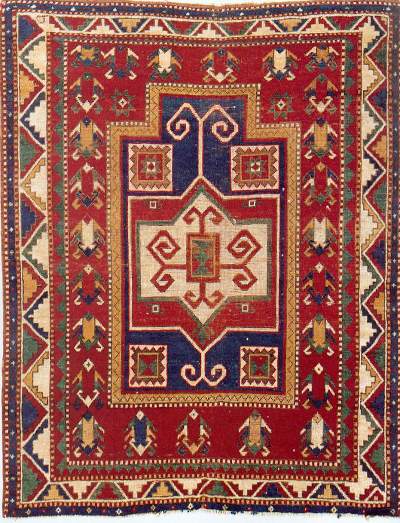
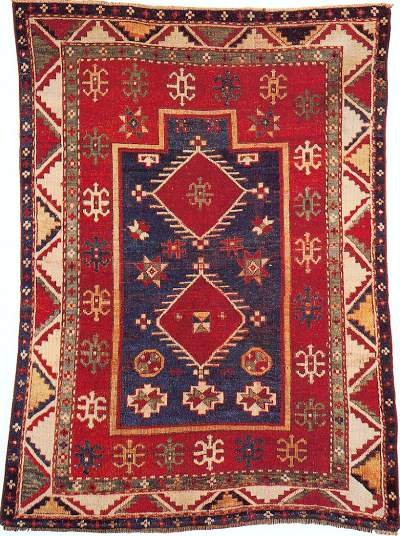
However the rug is so out of line with the known tradition that it should be
a candidate for closed scrutiny under suspicion of being a (old?) fake, as Michael’s
friend suggests.
Well, you know what? Even if it were an old “fake” I still consider it as an
authentic work of art and I would still prefer it to any old authentic prayer
rug.
Steve,
I agree on the point you make about age and “experienced judgment”. Especially
when the “experienced judge” happens to be also the seller.
Regards,
Filiberto
Posted by Bob Kent on 02-21-2006 10:50 AM:
hard to tell?
of course I have no idea about the yastik, but it is interesting to think of
how hard it may be to tell about the age of things... ?? the article in the
new yorker ("the rug missionary") several years back noted that 'new old rugs'/fakes/tributes/whatever
have been created in turkey, successfully, using old wool, perhaps even 200
year old kilim wool.
Posted by James Blanchard on 02-21-2006 11:11 AM:
Hi all,
It has only been a few years since I started to read more diligently about rugs
and peer in on discussions among collectors and dealers about dating rugs. It
strikes me that in the absence of any definitive proof or "gold standard" for
dating a piece, rug scholars are left with a couple of options:
1) Inductive reasoning: This is essentially "argument from observation", and
as far as I can tell in rug scholarship it tends to manifest itself as the ordering
design features and/or structure of a group of weavings into some sort of presumed
chronology. There might not be any good evidence to refute these chronologies,
but one can also not claim that they have proof that they are true. Of course
if there were enough samples where dates are known, a deductive process could
be undertaken to test and validate these inductively derived dating hypotheses.
2) Consensus of experts: From a scientific perspective this is an even weaker
approach than inductive processes since it doesn't necessarily rely on careful
study of the evidence and it is prone to the bias of "group think". So if conclusions
are made based on expert consensus there should be clear documentation of a
coherent line of reasoning from the agreeing scholars, and cogent arguments
from dissenters.
Of course part of what I like about rug appreciation is that it is far enough
removed from the humdrum of hard data. Can you imagine how uninteresting rug
collection, scholarship and commerce would be if each weaving had a small tag
that verified the date and attribution?
James.
Posted by Lars_Jurell on 02-21-2006 12:20 PM:
Hello again
In my reply above I did mention yastiks as pillows ( cusion covers ). Normaly
woven in one piece: front + back and then sawn together and filled with grass,
wool or something else to make a pillow for the back or to sit upon. This is
the tradition with yastiks.
When one find a yastik one must have in mind that they normaly are ment for
use. But, it can also have been woven as a dowry and keps somewhere without
beeing used. But in that way it will be complete front + back anyhow.
A "old and used" yastik will show patina from several years of use. And in shops
they can be complete with patina, complete with damage, only a front with patina
and often also with some damage or reaparations.
The pattern is only one of several things to look at before deside probably
age of the yastik.
It is easy to remove knots and change to other colours or to make repairs, all
to make it older and get more money.
If I see an "old" yastik front in mint condition when colours, patina, material
etc. are checked, I will be suspicious.
Some textiles can I buy from photo, but not a perfect one!
Lars Jurell
Posted by Filiberto Boncompagni on 02-21-2006 12:30 PM:
Hi Lars,
Sorry for my ignorance, but I never saw a yastik with the back. Could it be
that the norm was to remove it, as they used to do for Jaff bag faces, in order
to sell the front as a mat only?
Regards,
Filiberto
Posted by Cevat Kanig on 02-21-2006 01:27 PM:
Hi Filiberto,
I agree with you, in the late 70's and early 80's in Istanbul we use to cut
yastik's back to make it door Mat for European and American market, now we are
looking for uncut ones.I wonder how many collector have uncut ones over 100
years old, I was very young that time so we cut them all.
Posted by Steve Price on 02-21-2006 01:56 PM:
Hi Filiberto
The backs of bags are usually pretty uninteresting flatweaves, some solid color
and some striped, but not exciting either way. Cutting the backs off bags is
a longstanding practice. It's unusual to find any antique tribal bag with its
back still on it.
I think the major reason was to save shipping weight. Secondary reasons might
be that it's almost impossible to get a bag to lie flat or hang nicely on a
wall if the back is still on it.
I do recall an eBay vendor some years ago selling the backs of a pair of Belouch
bags as Kurdish bagfaces.
Regards
Steve Price
Posted by Lars_Jurell on 02-21-2006 03:56 PM:
Hello again
If you take a look at our Rug Society´s site ( AKREP ) you will find a yastik
from W Anatolia with a bit of the back still there.
On top you see circa 7 cm and on bottom there are 7-8 cm put behind because
of damage.
But I will remain it because it is a part of origin.
http://www.akrep.se/akrepny/26E%20Dazkiri%20yastik.htm
If this link doesn´t work, try http://www.akrep.se,/ then go to English verison, Gallery and
then number 26.
Notice also the "patina" and marks from many years use ( not on the link but
on the yastik! ).
I have 2 more komplete yastiks with backs but they are from beginning 20th century.
Regards
Lars Jurell
Posted by Cevat Kanig on 02-21-2006 04:23 PM:
Hi Folks,
Thanks god a couple lucky of them are still survives.
Regards.
Posted by Michael_Wendorf on 02-21-2006 06:20 PM:
on the topic of yastiks
Dear Filiberto:
I think you are asking some of the important questions ... I wish I had easier,
more definitive answers.
But, yes, I think this is an old piece and 100 years plus seems very likely
to me.
Yes, I used "fake" in a broader sense. Perhaps "unauthentic" is better, or the
term Richard Tomlinson used in a narrower sense - "contrived" or not genuine.
However, all of these terms seem pretty negative and undermine our ability to
really see this yastik. I think everyone would be well served to inform themselves
of the supposed stylistic incongruencies compared to the known traditions. Then
again, it could be as simple as the exhibit notes state: that this yastik was
made for a special purpose or made to order - if that is the case then the incongruencies
could be, well, inconsequential.
In any event, I think you can see the issue. Best, michael
Posted by Filiberto Boncompagni on 02-22-2006 01:19 AM:
Hi Michael,
Yes, I see the issue. On the other hand, considering as “contrived” a beautiful
piece that deviate from the tradition there is also the risk of grossly underestimate
the creativity of the weaver who made it.
That is, speaking about old pieces and not of modern “engineered” fakes like
the Zakatala mat I referred to before.
Best regards,
Filiberto
Posted by Wendel Swan on 02-22-2006 06:13 PM:
Dear all,
The Newman/Mast yastik deserves attention and analysis. I first saw it in the
early 80’s, before Ronnie Newman bought it, and I’ve seen it at least twice
since. It may well be the most well known yastik in existence, having been discussed
and published on many occasions.
Here, opinions on its aesthetics differ from “AWFUL !!!” (Richard) to “captivating”
(Michael), but there seems to be consistent questions about its age. I’ve had
similar doubts before, but I’ve never thought them through until now.
Although I haven’t seen it since 1996, my recollection of its physical characteristics
is like Michael’s: great colors, wool and handle. But some of the elements appear
to be at the end of a design continuum. And that makes it puzzling.
First, many centuries ago, lappets were separate flaps on the ends of cushions.
We see them on the ends of both Central Anatolian yastiks and rugs. In this
instance, the lappets are not contained within a conventional separate end border,
but are in a circumferential border.
Second, the lappets themselves are simplified, both in outline and interior
elements.
Third, the very simple “C” elements in the side borders are extremely rare (possibly
unique) for a yastik or any Turkish rug, for that matter.
Fourth, the shape of the ivory ground indicates derivation from a more complex,
possibly floral, format. In fact, all of the design elements are simplified.
Simplicity can be appealing. The graphics, colors and scale of the drawing are
all well balanced and are all excellent. But it is very non-traditional weaving
in a very traditional area. Its simplicity is not reason to give it an 18th
Century date, just as I don’t think that the simplicity of the Kaffel Kazak
is by itself an argument for greater age.
Here is a comparison between a Karapinar yastik that I own (John showed a picture
of it from the Keshishian party) and the Newman/Mast yastik, also thought to
be Karapinar (an inclusive term). While I like the purple and the green and
gold of my yastik, the drawing is much more static and it doesn’t have that
great ivory ground. It also comes from a different design tradition and group.
I think mine is at least 100 years old, but I would never pretend to an 18th
Century date for it. Yet it exhibits less design devolution (change, evolution,
adaptation – you pick the word) than does the Newman/Mast yastik.
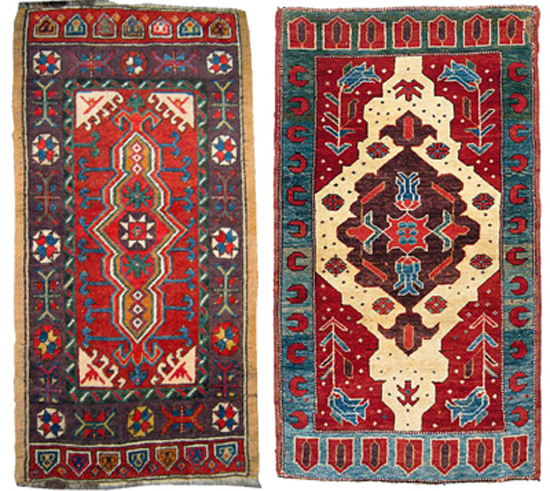
My eyes and fingers say love it (or at least they did) but my head sometimes
says not love it. Like Michael, I think it’s old, but I can’t say how old. I
don’t think it’s a “fake,” primarily because fakes reproduce older objects.
This piece is too different to have been a repro.
Best,
Wendel
Posted by Jerry Silverman on 02-22-2006 06:33 PM:
If you could persuade the owner to let you borrow it for a weekend, this yastik
would make a tasty item for the "Mystery Rug" session at ACOR you'll be moderating,
Wendel.
Cordially,
-Jerry-
Posted by Filiberto Boncompagni on 02-23-2006 02:39 AM:
Thanks Wendel for your clarifying contribution.
In spite of the divergences of opinions on the aesthetic quality of this yastik,
there is one point on which everybody - experts and laymen - seems to agree:
this is hardly an 18th rug.
More interestingly, the doubt is expressed by two of the more knowledgeable
persons here - and they have handled the rug personally.
Even Morehouse didn’t think that the yastik was that old: John wrote that Morehouse
prudently refrained from providing age estimates of the pieces in his book BUT
he dated one - plate 101- as 1831, the oldest dated yastik we appear to have.
Therefore, if I understand correctly, he didn’t think that plate 59 was older
than that.
It would be interesting to know what Mr. Dodds thinks about this matter.
Regards,
Filiberto
Posted by R. John Howe on 02-23-2006 04:33 AM:
Filiberto, Wendel et al -
I don't think that Morehouse is saying that the "dated" yastik is older than
the Mast piece that started this thread, I think he is saying that it has a
date written on it (although I can't spot it in his small image in the book)
and it is the oldest one we have with such a written date. (Morehouse shows
actual images of three pieces estimated to have been made in the 17th century.)
I think the examination of this piece is getting more thoughtful, but notice
that Wendel seems to assume that the usual progression from more articulated
to more abstracted modes holds for this piece. It's clear that such progression
happens a lot, but I also, I thought, demonstrated with at least two pieces,
one a velvet and silver Turkish yastik, and the other the Kaffel Kazak, that
we cannot simply assume this in a particular instance. Sometimes the move is
to elabloration of an "earlier" design.
Now I agree that the simplicity of a piece is not a reason to give it an earlier
date (and that is not what I argued). Only that our usual assumptions about
progression from more elaborate to more simplified designs can be shown sometimes
not to be the case.
And I say all that without defending the date given in the gallery label for
the Mast piece at all. I have no basis for estimating it's age. I think there
are some signs that the age estimates in this exhibition are sometimes optimistic
(hardly a new thing in the rug world). Pinner would call all of the estimates
being made "conventional." That is, none of them, is based on any objective
data tied to actual dates.
Filiberto, I think we know what Mr. Dodds thinks about this matter. He wrote
the gallery label. He indicates the older pieces with which he thinks this one
can be associated. Again, a conventional argument.
Regards,
R. John Howe
Posted by Filiberto Boncompagni on 02-23-2006 04:51 AM:
Hi John,
Well, it appears that I didn’t understand correctly what you wrote about
Morehouse, after all.
Regards,
Filiberto
Posted by Gene Williams on 03-21-2006 05:22 AM:
Yastik with a back
Filiberto,
I assume a Yastik is a pillow. This may not contribute much to the topic on
this Turkish Yastik but offer the following on my experience with Baluch pillows.
I have 10-12 baluch pillows with flatweave backs intact. 5-6 are actually in
use in the house stuffed with cotton, their goat hair bound selvedges intact.
there is a small opening maybe 4-5 inches long on the "top" selvage of each
pillow in which the cotton is stuffed.
The bottom of a few of these pillows are lined with kepri shells with small
holes drilled in them with the goat hair selvedge run through the holes. And,
I have several which are not stuffed but which have intact backs but with the
ends loose...
Most of these look to be quite old as Baluch go... a couple look very old with
patina. Only one has really noticeable wear though; this is a large pillow with
a "doctor-i-qazi" design, shells along the bottom and some tufts and dangling
cords at the corner...it has a pronounced band of wear, maybe 2 inches wide
across the entire pillow about 3-4" from the top... The rest don't seem to have
much wear at all...maybe people leaning against them don't wear them as much
as a foot would.
As for age of these pillows, I can only testify that I bought them around 1975-76
and that they looked old then.
Again when I get home, I'll put pics on so you all can evaluate them.
Posted by R._John_Howe on 03-21-2006 10:46 AM:
Hi Gene -
Yes, a yastik is Turkish term for pillow cover. As indicated above, they are
rarely found with backs. I mean even less frequently than many tribal bags are.
Turkish homes often had divan arrangements and the yastiks were placed at the
back presumably for comfort.
So far there is only one book devoted to this format. It is by Brian Morehouse,
a California collector and student of oriental weavings. His volume appeared
in 1996 in conjunction with an exhibition of many if not all of the yastiks
in it in Philadelphia at an ICOC conference.
Dennis Dodds, who curated the Anatolian exhibition to which this general post
on Turkotek is devoted is also a noteworthy collector of yastiks.
There are similar formats in other settings but some of them seem to have been
parts of bags rather than pillow covers. On the other hand, many tribal weavings
seem to have had multiple uses.
Regards,
R. John Howe
Posted by Wendel Swan on 03-29-2006 02:57 PM:
Dear all,
I briefly visited the Anatolian exhibition at the Arthur Ross Gallery in Philadelphia
this past weekend, but my time was very limited. I’m not at all sure that my
spending an hour or two with the yastik would have yielded any more insight
into the issues discussed here.
Anyone who still has the chance should visit the exhibition, but it closes this
Sunday, April 2.
The Newman/Mast yastik is pretty much as I remembered it: wonderful colors and
wool. Overall, it’s in excellent condition with a very few old and visible repairs.
As to the 18th Century date, Dennis Dodds relied on comparisons to other Turkish
rugs and, in particular, to one that is also in the exhibition. The rug to which
he compares it is rather well known and spectacular itself.
Here is the yastik side by side with the Karapinar rug (7’4” long) that Dennis
attributes to the 17th Century. The “kilim style” of the rug is rather similar
to the yastik and Dennis reports some consistent structural features as well.
(I didn’t see the back of the rug on this visit.)
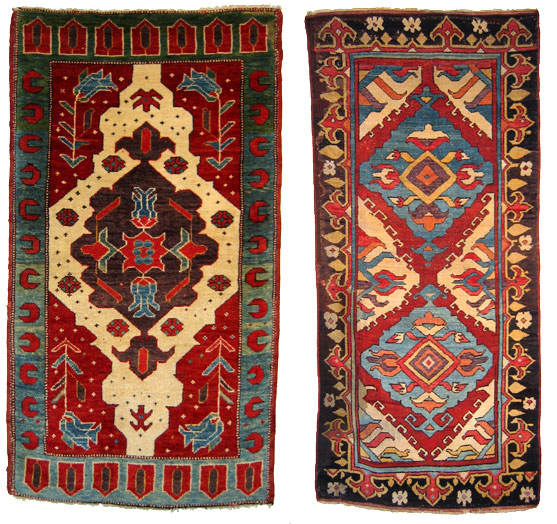
The back of the yastik looks like this (quite fine):
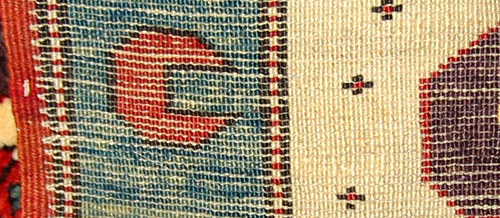
The Karapinar rug and the yastik have quite similar design styles (a casual
aspect) and color palettes, as is evident. There are a few other rugs of the
period(s) done in a similar style, but I’m not familiar enough with that group
to draw any conclusions.
Dennis has collected and studied Turkish rugs for many years and has a distinguished
collection of yastiks. While any of us are free to disagree with his (or anyone
else’s) attribution or dating), in this instance his opinions are, I believe,
certainly credible.
I never thought the yastik was a fake and this visit confirmed my previous belief.
Although I have known Dennis’ Karapinar rug for years, I never thought to associate
it with the yastik. I should have.
Wendel
Posted by Ben Mini on 03-29-2006 05:19 PM:
18th century?
I just can't swallow an 18th c. attribution. For starters, I would like to
compare this yastik to all other known 18th c. yastiks. Does anybody know of
an 18th c. pile yastik to compare this piece to? That would be a good place
to start.
I recently noticed that Bertram Frauenknecht had posted a Yastik described as
18th c. on his website. That yastik seems a far, far better candidate for '18th
c. pile yastik' than the piece now in consideration-- the colors, drawing, condition,
etc seem to attest to real age. What is it about the Philadelphia yastik that
attests to real age? Am I missing something? The drawing looks pretty stiff
to me, particularly the medallion and those tulips. The photo of the back does
nothing to convince me of an early date. In fact, it does quite the opposite.
I also want to mention that the condition of the Philadelphia yastik is a real
issue for me. Yastiks were 'utilitarian' things, right? Rug collectors weren't
really interested in yastiks until quite recenly, right? So isn't it a little
hard to swallow that an 18th c. yastik would be in stellar condition?
I don't want to offend or pick a fight, but I can't be alone in finding the
18th c. attribution to be a bit fanciful.
Thanks for hearing me out,
Ben Mini
Posted by Steve Price on 03-29-2006 06:18 PM:
Hi Ben
You wrote, I would like to compare this yastik to all other known 18th c.
yastiks. Does anybody know of an 18th c. pile yastik to compare this piece to?
There probably isn't a single yastik in captivity that can be documented to
have existed in the 18th century. This means that dating can't have much certainty.
I don't think this problem is unique to yastiks, by the way.
Condition is a very unreliable criterion of age, especially for something like
a yastik. They were used indoors, and were not subject to foot traffic. Hard
to know what to expect the condition to be, and your arguments from condition
would apply to 19th century (or even mid-20th century) attributions as well
as to 18th century attributions.
Regards
Steve Price
Posted by R. John Howe on 03-29-2006 06:19 PM:
Hi Mr. Mini -
I don't know if the Philadelphia yastik is 18th century either, but I just took
a look at your Frauenknecht example and it is worn, worn but it is also (look
at it again) simple, simple.
For me, it doesn't work as a convincing counter example, although there may
well be such.
Regards,
R. John Howe
Posted by Ben Mini on 03-29-2006 06:30 PM:
Mr. Howe,
I don't at all find the Frauenknecht piece to be simple as you claim. Look at
the exquisite play between positive and negative space, particularly in the
border but also within the medallion and parts of the field. This is the the
sort of articulated drawing I would expect on an early piece, and that I find
particularly lacking in the Philadelphia yastik.
Regards,
Ben Mini
Posted by Steve Price on 03-29-2006 06:47 PM:
Hi Ben
Although we try to avoid discussing rugs that are on the market, we make exceptions
when one is fairly crucial to an ongoing discussion. I assume that Frauenknecht's
piece is for sale, but it would facilitate this discussion to be able to see
it. Can you give us a link to it?
Regards
Steve Price
Posted by Ben Mini on 03-29-2006 07:21 PM:
http://www.frauenknecht.com/html/angebot2005/picturedetail2.html
Ed. note: The link no longer goes to a page with the yastik fragment. Since
it isn't on our server, there's not much we can do about it. Steve Price
Posted by Steve Price on 03-29-2006 09:20 PM:
Hi Ben
Thanks for the link. It certainly isn't new.
Regards
Steve Price
Posted by Tim Adam on 03-29-2006 11:42 PM:
Hello all,
I went to see the exhibition today, and largely agree with Wendel. The wool
is incredibly soft. The colors are great, except for the purple-brown of the
central medallion. This color I find relatively dull, but it may be just me.
The abrash of the border is pretty phantastic, with the blue shades going towards
the green in the upper part of the yastic. This cannot be seen correctly in
the digital image. Otherwise it is actually pretty close to the real thing.
Although there is no patina on the yastic whatsoever, it really looks like as
if it has come right off the loom, the brown outlines are corroded, and even
the red within the central medallion shows minimal corrosion. So, I am convinced
the yastic is old.
What I found most remarkable is that despite the abrash, which is all over this
piece, it still looks, at least to me, rather two-dimensional (except for the
border).
The other thing I find rather unusual is the rendition of the flowers in the
spandrels. Has anyone seen a similar rendition in another piece?
Tim





 I am a new collector with limited
experience, so of I have no idea about the yastik. But I do wonder how datings
to for example the 18th C for a yastik -- certainly, a utilitarian, unsigned,
and undated thing in its day, and not the sort of thing with a chain of custody
back that far -- might be done. If there isn't a useful physical C-14 sort of
test (and I suppose even if there were the wool could be old in a repair, etc),
then I guess design and structure, as the legend in the show suggests, might
be used to gauge age. Design could be misleading - an old design might reused,
like a replica car or house with archaic design. And if structure is a guide,
surely the best restorers know as much as collectors about structural things,
so in the presence of much higher prices for things deemed really old, things
might be restored in convenient ways?
I am a new collector with limited
experience, so of I have no idea about the yastik. But I do wonder how datings
to for example the 18th C for a yastik -- certainly, a utilitarian, unsigned,
and undated thing in its day, and not the sort of thing with a chain of custody
back that far -- might be done. If there isn't a useful physical C-14 sort of
test (and I suppose even if there were the wool could be old in a repair, etc),
then I guess design and structure, as the legend in the show suggests, might
be used to gauge age. Design could be misleading - an old design might reused,
like a replica car or house with archaic design. And if structure is a guide,
surely the best restorers know as much as collectors about structural things,
so in the presence of much higher prices for things deemed really old, things
might be restored in convenient ways? ). I had pretty much the same reactions as you did, except for the final conclusion.
I don't think it is awful, but I would surely not pay those mega bucks for it.
). I had pretty much the same reactions as you did, except for the final conclusion.
I don't think it is awful, but I would surely not pay those mega bucks for it.







